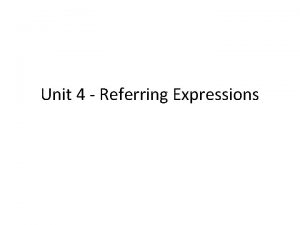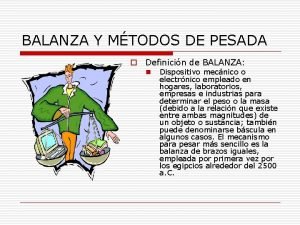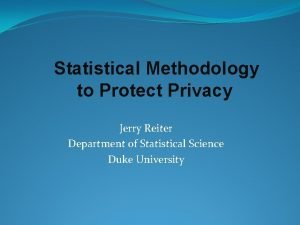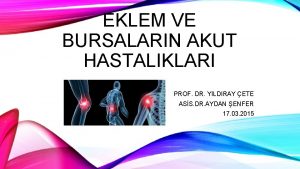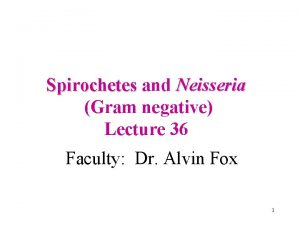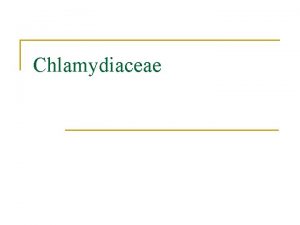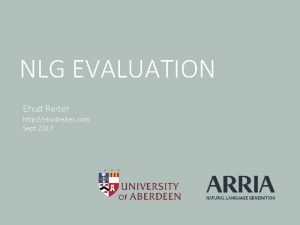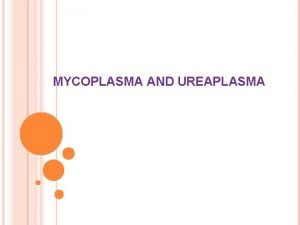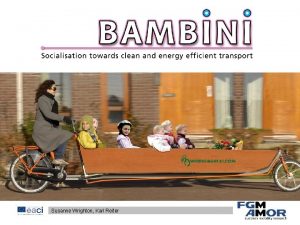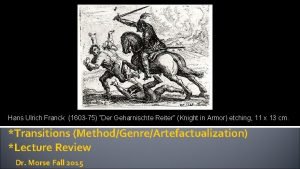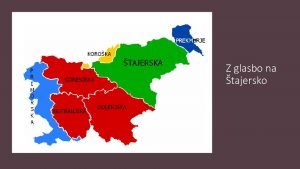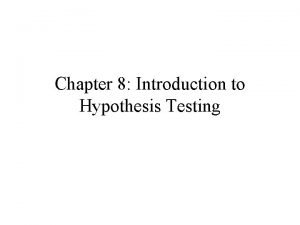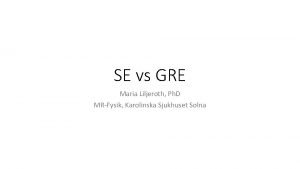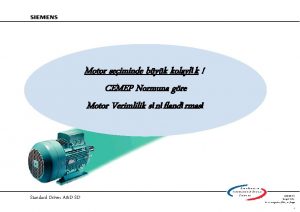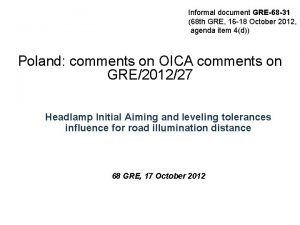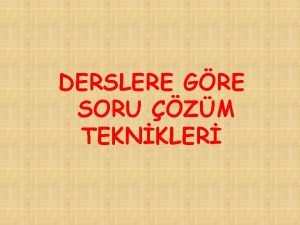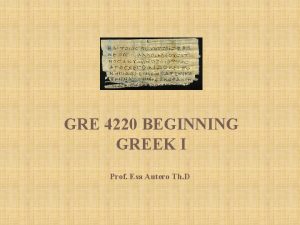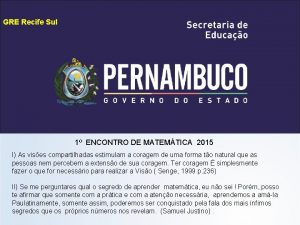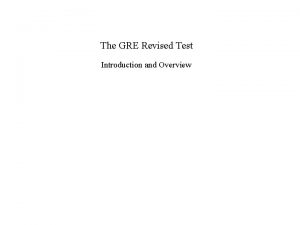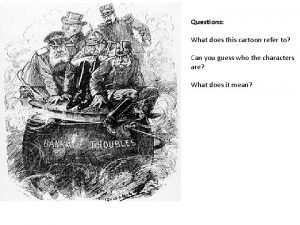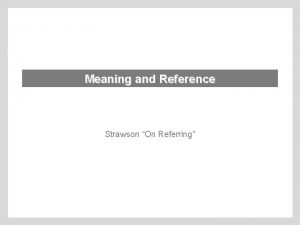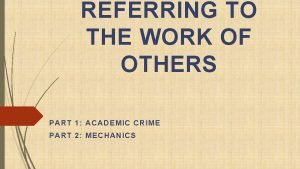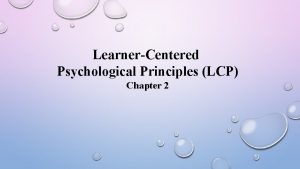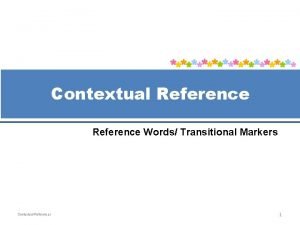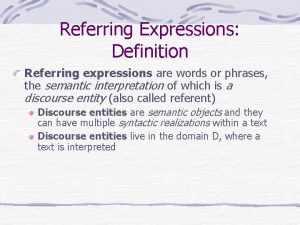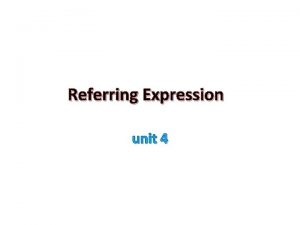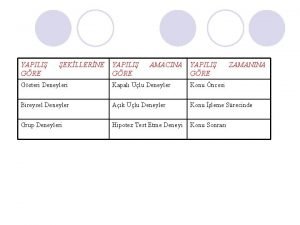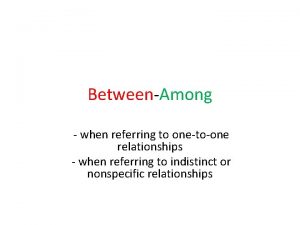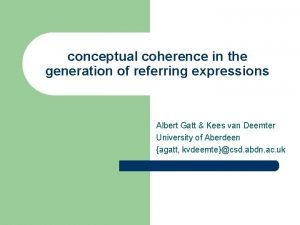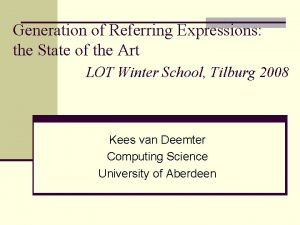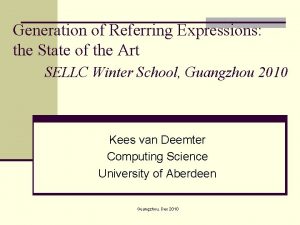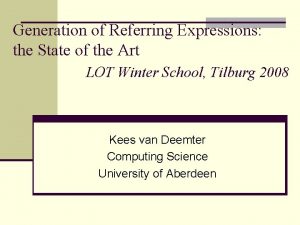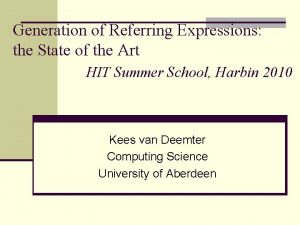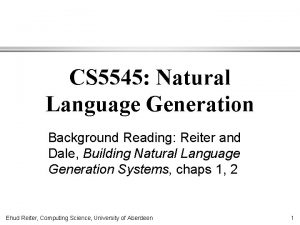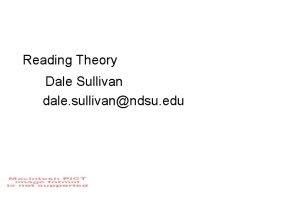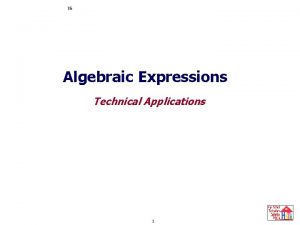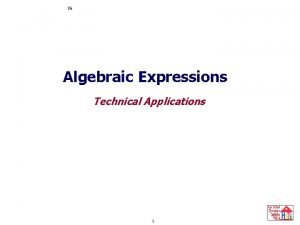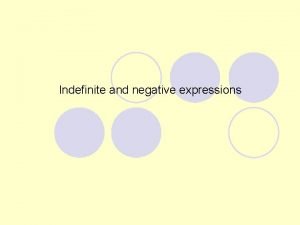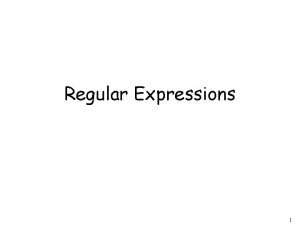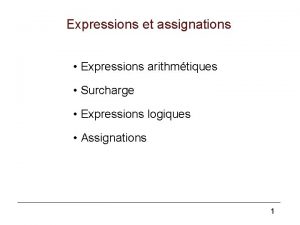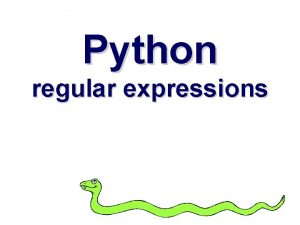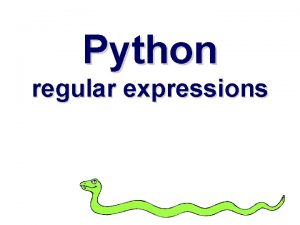Generation of Referring Expressions GRE Reading Dale Reiter








![…people don’t speak this way For example, – [Manner] ‘the red chair’ (when there …people don’t speak this way For example, – [Manner] ‘the red chair’ (when there](https://slidetodoc.com/presentation_image_h2/5b980765e16495a1d99290b8e1701dc3/image-9.jpg)


































- Slides: 43

Generation of Referring Expressions (GRE) Reading: Dale & Reiter (1995) (key paper in this area)

The task: GRE • NLG can have different kinds of inputs: – ‘Flat’ data (collections of atoms, e. g. , in the tables of a database) – Logically complex data • In both cases, unfamiliar constants may be used, and this is sometimes unavoidable

No familiar constant available: 1. The referent has a familiar name, but it’s not unique, e. g. , ‘John Smith’ 2. The referent has no familiar name: trains, furniture, trees, atomic particles, … ( In such cases, databases use database keys, e. g. , ‘Smith$73527$’, ‘TRAIN-3821’ ) 3. Similar: sets of objects (lecture 4).

• Natural Languages are too economic to have a proper name for everything • Names may not even be most appropriate • So, speakers/NLG systems have to invent ways of referring to things. E. g. , ‘the 7: 38 Trenton express’ • Note: the problem arises whether the referent is a token or a type

• GRE tries to find the best description • GRE is microcosm of NLG: e. g. , determines – which properties to express (Content Determination) – which syntactic configuration to use (Syntactic Realization) – which words to choose (Lexical Choice)

This lecture: • Simplification 1: Content Determination only (until lecture 5). • Simplification 2: Definite descriptions only (Pronouns, demonstratives, etc. , are disregarded; until tomorrow)

Dale & Reiter (1995): best description fulfills the Gricean maxims. E. g. , • (Quality: ) list properties truthfully • (Quantity: ) list sufficient properties to allow hearer to identify referent – but not more • (Relevance: ) use properties that are of interest in themselves * • (Manner: ) be brief * Slightly different from D&R 1995

D&R’s expectation: • Violation of a maxim leads to implicatures. • For example, – [Quantity] ‘the pitbull’ (when there is only one dog). – [Manner] ‘Get the cordless drill that’s in the toolbox’ (Appelt). • There’s just one problem: …
![people dont speak this way For example Manner the red chair when there …people don’t speak this way For example, – [Manner] ‘the red chair’ (when there](https://slidetodoc.com/presentation_image_h2/5b980765e16495a1d99290b8e1701dc3/image-9.jpg)
…people don’t speak this way For example, – [Manner] ‘the red chair’ (when there is only one red object in the domain). – [Manner/Quantity] ‘I broke my arm’ (when I have two). General: empirical work shows much redundancy Similar for other maxims, e. g. , – [Quality] ‘the man with the martini’ (Donellan)

Example Situation c, £ 100 Swedish a, £ 100 d, £ 150 Italian b, £ 150 e, £?

Formalized in a KB • • • Type: furniture (abcde), desk (ab), chair (cde) Origin: Sweden (ac), Italy (bde) Colours: dark (ade), light (bc), grey (a) Price: 100 (ac), 150 (bd) , 250 ({}) Contains: wood ({}), metal ({abcde}), cotton(d) Assumption: all this is shared knowledge.

Violations of … • Manner: * ‘The £ 100 grey Swedish desk which is made of metal’ (Description of a) • Relevance: ‘The cotton chair is a fire hazard? ? Then why not buy the Swedish chair? ’ (Descriptions of d and c respectively)

• In fact, there is a second problem with Manner. Consider the following formalization: Full Brevity: Never use more than the minimal number of properties required for identification (Dale 1989) An algorithm:

Dale 1989: 1. Check whether 1 property is enough 2. Check whether 2 properties is enough …. Etc. , until success {minimal description is generated} or failure {no description is possible}

Problem: exponential complexity • Worst-case, this algorithm would have to inspect all combinations of properties. n properties combinations. • Recall: one grain of rice on square one; twice as many on any subsequent square. • Some algorithms may be faster, but … • Theoretical result: algorithm must be exponential in the number of properties.

• D&R conclude that Full Brevity cannot be achieved in practice. • They designed an algorithm that only approximates Full Brevity: the Incremental Algorithm.

Incremental Algorithm (informal): • Properties are considered in a fixed order: P= • A property is included if it is ‘useful’: true of target; false of some distractors • Stop when done; so earlier properties have a greater chance of being included. (E. g. , a perceptually salient property) • Therefore called preference order.

• • r = individual to be described P = list of properties, in preference order P is a property L= properties in generated description (Recall: we’re not worried about realization today)


P = < furniture (abcde), desk (ab), chair (cde), Swedish (ac), Italian (bde), dark (ade), light (bc), grey (a), 100£ ({ac}), 150£(bd) , 250£ ({}), wooden ({}), metal (abcde), cotton ({d}) > Domain = {a, b, c, d, e}. Now describe: a = <. . . > d = <. . . > e = <. . . >

P = < furniture (abcde), desk (ab), chair (cde), Swedish (ac), Italian (bde), dark (ade), light (bc), grey (a), 100£ (ac), 200£ (bd), 250£ ({}), wooden ({}), metal (abcde), cotton (d) > Domain = {a, b, c, d, e}. Now describe: a = <desk {ab}, Swedish {ac}> d = <chair, Italian, dark, 200> (Nonminimal) e = <chair, Italian, dark, . . > (Impossible)

[ An aside: shared info will be assumed to be complete and uncontroversial. Consider • Speaker: [[Student]] = {a, b, …} • Hearer: [[Student]] = {a, c, …} Does this make a referable? ]

Incremental Algorithm • It’s a hillclimbing algorithm: ever better approximations of a successful description. • ‘Incremental’ means no backtracking. • Not always the minimal number of properties.

Incremental Algorithm • Logical completeness: A unique description is found in finite time if there exists one. (Given reasonable assumptions, see van Deemter 2002) • Computational complexity: Assume that testing for usefulness takes constant time. Then worst-case time complexity is O(np) where np is the number of properties in P.

Better approximation of Full Brevity (D&R 1995) • Attribute + Value model: Properties grouped together as in original example: Origin: Sweden, Italy, . . . Colour: dark, grey, . . . • Optimization within the set of properties based on the same Attribute

Incremental Algorithm, using Attributes and Values • r = individual to be described • A = list of Attributes, in preference order • Def: = Value i of Attribute j • L= properties in generated description


• Find. Best. Value(r, A): - Find Values of A that are true of r, while removing some distractors (If these don’t exist, go to next Attribute) - Within this set, select the Value that removes the largest number of distractors - If there’s a tie, select the most general one - If there’s still a tie, select an arbitrary one

Example: D = {a, b, c, d, f, g} • Type: furniture (abcd), desk (ab), chair (cd) • Origin: Europe (bdfg), USA (ac), Italy (bd) Describe a: {desk, American} (furniture removes fewer distractors than desk) Describe b: {desk, European} (European is more general than Italian) N. B. This disregards relevance, etc.

P. S. Note the similarity with Van Rooy & Dekker’s semantic of answers: Let A and B be truthful answers to a question, then A is a better answer than B Utility(A) > Utility(B) or Utility(A) = Utility(B) & B A (More about this in the next lecture …)

• Exercise on Logical Completeness: Construct an example where no description is found, although one exists. • Hint: Let Attribute have Values whose extensions overlap.

Example: D = {a, b, c, d, f} • Contains: wood (abe), plastic (acdf) • Colour: grey (ab), yellow (cd) Describe a: {wood, grey, . . . } - Failure (wood removes more distractors than plastic) Compare: Describe a: {plastic, grey} - Success

Complexity of the algorithm nd = nr. of distractors nl = nr. of properties in the description nv = nr. of Values (for all Attributes) Alternative assessment: O(nv) (Worst-case running time) According to D&R: O(nd nl ) (Typical running time)

Minor complication: Head nouns • Another way in which human descriptions are nonminimal – A description needs a Noun, but not all properties are expressed as Nouns – Example: Suppose Colour was the most-preferred Attribute, and target = a

• • • Colours: dark (ade), light (bc), grey (a) Type: furniture (abcde), desk (ab), chair (cde) Origin: Sweden (ac), Italy (bde) Price: 100 (ac), 150 (bd) , 250 ({}) Contains: wood ({}), metal ({abcde}), cotton(d) target = a Describe a: {grey} ‘The grey’ ? (Not in English)

D&R’s repair: • Assume that Values of the Attribute Type can be expressed in a Noun. • After the core algorithm: - check whether Type is represented. - if not, then add the best Value of the Type Attribute to the description

• Versions of Dale and Reiter’s Incremental Algorithm have often been implemented • Still the starting point for many new algorithms. (See later lectures. ) • Worth reading!

Limitations of the algorithm 1. Redundancy does not arise for principled reasons, e. g. , for - marking topic changes, etc. (Corpus work by Pam Jordan et. al. ) - making it easy to find the referent (Experimental work by Paraboni et al. - Next lecture)

Limitations of the algorithm 2. Targets are individual objects, never sets. What changes when target = {a, b, c} ? (Lecture 4) 3. Incremental algorithm uses only conjunctions of atomic properties. No negations, disjunctions, etc. (Lecture 4)

Limitations of the algorithm 4. No relations with other objects, e. g. , ‘the orange on the table’. (Lecture 3) 5. Differences in salience are not taken into account. (Lecture 3) 6. Language realization is disregarded. (Lecture 5)

Discussion: How bad is it for a GRE algorithm to take exponential time? – More complex types of referring expressions problem becomes even harder – Restrict to combinations whose length is less than x problem not exponential. – Example: descriptions containing a most n properties (Full Brevity)

However: – “Mathematicians’ view”: structure of problem shows when no restrictions are put. – What if the input does not conform with these restrictions? (GRE does not control its own input!)

• Compare with Description Logic: - Increasingly complex algorithms … - that tackle larger and larger fragments of logic … - and whose complexity is ‘conservative’ • Question: how do human speakers cope?
 Referring expressions examples
Referring expressions examples Pre reading while reading and post reading activities
Pre reading while reading and post reading activities Reiter balanza
Reiter balanza Dr pugliese allergist
Dr pugliese allergist Keith reiter
Keith reiter Jerry reiter duke
Jerry reiter duke Diana reiter schindler's list
Diana reiter schindler's list Psödogut
Psödogut Lou reiter
Lou reiter Reiter’s syndrome
Reiter’s syndrome Jeff reiter
Jeff reiter Reiter’s syndrome
Reiter’s syndrome Ehud reiter
Ehud reiter Lifecell myco
Lifecell myco Karl reiter
Karl reiter Hans ulrich franck
Hans ulrich franck Reiter's syndrome
Reiter's syndrome First gen antipsychotics
First gen antipsychotics Oh lord you are good and your mercy endureth forever
Oh lord you are good and your mercy endureth forever Iz zemlje gre v trto
Iz zemlje gre v trto Kaplan gre
Kaplan gre Gre quantitative comparison
Gre quantitative comparison Cem yurtsev
Cem yurtsev Maria gre
Maria gre Motor gre
Motor gre Gre exam syllabus
Gre exam syllabus Gre
Gre Gre bakery
Gre bakery Gre sınav soruları
Gre sınav soruları Peter gre
Peter gre I prof gre
I prof gre Gre recife sul
Gre recife sul Difference of t distribution and normal distribution
Difference of t distribution and normal distribution Postgre pronounce
Postgre pronounce What is the purpose of the gre
What is the purpose of the gre Gre elaboration
Gre elaboration Television promotes gre
Television promotes gre The narratives that vanquished peoples
The narratives that vanquished peoples Gre
Gre Moroccan crisis cartoon
Moroccan crisis cartoon On referring strawson
On referring strawson Referring others
Referring others 14 learner centered psychological principles
14 learner centered psychological principles Types of reference words
Types of reference words
